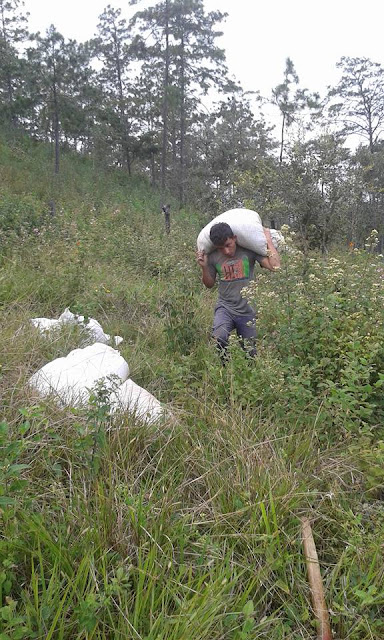As missionaries living and working in a foreign country, in a place where the people are very poor and have little education, many times there are things that we can teach them . . . but, frequently they are teaching
us, especially about how to get things done in this specific place, using manpower, freely available materials, and very little money!
Last month, we planted the seeds, to start the plants which will be transplanted to our coffee fields late this year. Most of our work crew grew up in a farming community, and this work is very familiar to them . . . and they are people who know how to work hard and how to manage to get things done without purchasing much. Here's a photo-journal of the process:
 |
This is sandy dirt we had hauled in - the very young coffee seedlings prefer to
grow in this medium. The seeds and young seedlings are watered frequently,
and here in the tropics the drainage properties of sand help prevent mold and
fungus from developing. |
 |
The workers bagged up the sand up by the driveway, and then carried the
sacks down to the coffee growing area, to set up the raised bed for the seeds. |
 |
| The spot chosen for the bed was cleared of weeds and grass. |
 |
| Logs from trees on our property were hauled in to make the edges of the bed. |
 |
| The logs will keep the sand from spreading out. |
 |
| The workers smoothed out the sand to prepare for planting. |
 |
| Stakes, again created from trees on our property, hold the logs in place. |
 |
| Small trenches were created for the seeds . . . |
 |
. . . and then the seeds (coffee beans) were placed into the trenches - a
surprisingly large quantity of seeds per inch! |
 |
| With the seeds in place, the workers gently smoothed sand over them. |
 |
| With a layer of straw on top to hold in moisture, the planted bed is complete. |
The next step in the process, once the seeds have germinated and popped through the sand to the surface, is removing the straw, and creating a low "roof" out of sticks covered with straw, to continue to shade the young plants while still giving them room to grow and access to limited sunlight. That should happen about 1 - 2 months after planting, so expect photos of that, when the time comes.
Thanks, Russell, for these photos, as well as for all of your hard work on this project - which we are doing with the goal of adding a sustainability aspect to the ministry here.



























No comments:
Post a Comment